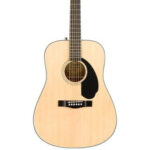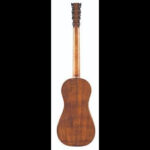The F chord. For many aspiring guitarists, these two characters can evoke feelings of frustration and defeat. It’s often cited as one of the most challenging chords for beginners to learn, a stumbling block on the path to guitar mastery. But don’t let the rumors intimidate you! While the full barre F chord can be tricky at first, it’s also an incredibly important chord to learn.
In this guide, we’ll break down the F chord into manageable steps, starting with easier versions and gradually progressing to the full barre. We’ll explore why this chord is so essential and provide practical tips to help you conquer the infamous F chord and expand your guitar playing repertoire.
Why is the F Chord So Important?
Simply put, the F chord is everywhere in music. From classic rock anthems to contemporary pop hits, country ballads to soulful R&B, the F major chord is a foundational element in countless songs across genres and decades. Ignoring it would be like trying to build a house without bricks – you’d be missing a crucial building block.
Here’s just a small taste of the songs that rely on the F chord:
Rock Anthems and Classics
The F chord resonates throughout rock history. Think of timeless tracks like:
- “Have You Ever Seen the Rain?” by Creedence Clearwater Revival
- “Heart Full of Soul” by The Yardbirds
- “La Bamba” by Ritchie Valens
- “Another Brick in the Wall Pt. 2” by Pink Floyd
- “Sister Christian” by Night Ranger
- The Beatles classics like “From Me To You” and “Misery”
Country Hits
The F chord is equally at home in country music, featuring in popular songs such as:
- “She’s Everything” by Brad Paisley
- “Snapback” by Old Dominion
- “Tattoos & Scars” by Montgomery Gentry
- Country standards like “Hey Good Lookin'” by Hank Williams
- “A Thousand Miles From Nowhere” by Dwight Yoakam
Pop and R&B Sensations
Tune into any pop radio station, and you’re likely to hear the F chord in hits like:
- “Can’t Feel My Face” by The Weeknd
- “Like I’m Gonna Lose You” by Meghan Trainor
- “Say Something” by A Great Big World
- “With Or Without You” by U2
As you can see, mastering the F chord unlocks a vast library of songs and expands your musical horizons significantly.
Step-by-Step: Learning to Play the F Chord
To make learning the F chord less daunting, we’ll start with simplified versions and gradually work our way up to the full barre chord. This progressive approach will build your finger strength and coordination without overwhelming you.
Version 1: The 3-Note F Chord (Easy Start)
This simplified version is an excellent starting point. It focuses on the essential notes of the F chord and avoids the barre, making it much easier for beginners.
Finger Placement:
- Index finger: 1st fret of the B (2nd) string
- Middle finger: 2nd fret of the G (3rd) string
- Ring finger: 3rd fret of the D (4th) string
Strumming: Strum down across the D, G, and B strings (the top three strings in this chord shape).
Why this version works: This version is less demanding on your fingers and wrist. It’s similar in shape to a C major chord but requires less finger stretching, making it a comfortable introduction to the F chord sound. It’s perfect for practicing chord changes and getting your fingers familiar with the fretboard positions.
Version 2: Adding the High E String (Mini Barre)
Once you feel comfortable with the 3-note version, it’s time to enrich the sound slightly by including the high E string. This version introduces a mini-barre, preparing you for the full barre chord later on.
Finger Placement:
- Index finger: Barre across the 1st fret of both the E (1st) and B (2nd) strings
- Middle finger: 2nd fret of the G (3rd) string
- Ring finger: 3rd fret of the D (4th) string
Strumming: Strum down across the D, G, B, and high E strings (the top four strings in this shape).
Progression: This version builds upon the first by incorporating a small barre with your index finger. This mini-barre strengthens your index finger and gets you used to pressing down multiple strings simultaneously – a crucial skill for the full barre chord.
Version 3: The Full Barre F Chord (1st Position)
Now it’s time to tackle the version that often causes beginners headaches – the full barre F chord in the 1st position. This is the “standard” F chord and a badge of honor for any guitarist to master.
Finger Placement:
- Index finger: Barre across all six strings at the 1st fret. Ensure each string rings clearly.
- Middle finger: 2nd fret of the G (3rd) string
- Ring finger: 3rd fret of the A (5th) string
- Pinky finger: 3rd fret of the D (4th) string
Strumming: Strum all six strings down from the low E string.
The Challenge: The difficulty of this chord stems from the index finger barre across all six strings, especially at the 1st fret where string tension is highest and the space between the nut and fret is wider. Achieving a clean sound requires sufficient finger strength and precise pressure across the entire barre. This takes practice and patience!
Version 4: Barre Chord F in the 8th Position (Higher Octave)
For a different voicing of the F chord, and to explore barre chords further up the neck, try the F barre chord in the 8th position. This version offers a brighter tone and is useful in different musical contexts.
Finger Placement:
- Index finger: Barre across the 8th fret of the A (5th) string to the high E (1st) string (5 strings total)
- Middle finger: 10th fret of the D (4th) string
- Ring finger: 10th fret of the G (3rd) string
- Pinky finger: 10th fret of the B (2nd) string
Strumming: Strum down across the A, D, G, B, and high E strings (the top five strings in this shape).
Why this version is useful: This barre chord shape is movable, meaning you can play other major chords by simply shifting this shape up or down the neck. It also provides a higher-pitched F chord voicing, which can be musically effective in certain songs and arrangements.
Tips and Practice Strategies for Mastering the F Chord
Conquering the F chord takes time and consistent practice. Here are some helpful tips to accelerate your progress:
- Start with an Electric Guitar: If possible, begin practicing the full barre F chord on an electric guitar. Electric guitars generally have lighter string tension than acoustics, making barre chords less physically demanding initially. This allows you to focus on proper finger placement and technique without fighting excessive string resistance.
- Take it Slow and Steady: Rome wasn’t built in a day, and neither is F chord mastery! Don’t expect to nail it immediately. Practice in short, focused sessions. Consistency is more effective than marathon practice sessions when learning new chords.
- Listen for Clarity: Strum the chord slowly and deliberately, string by string. Identify any strings that are buzzing or muted. Adjust your finger pressure and placement until each string rings out clearly.
- Don’t Ignore Wrist Pain: If you experience any wrist pain, stop immediately and rest. Pain is a signal that something is wrong. Ensure your wrist is relaxed and not bent at an extreme angle. Proper posture and guitar positioning are crucial for avoiding injuries.
- Practice Chord Changes: Once you can play the F chord cleanly by itself, start practicing transitions between F and other common chords. Excellent chords to practice with F include C major, G major, and Bb major. Start with F to C and F to G, then progress to the F to Bb change, which involves moving between two barre chords.
- Warm-up Your Hands: Before practicing, do some simple hand and wrist warm-up exercises. This will improve circulation and flexibility, making chord practice more comfortable and effective.
The F chord’s reputation for being difficult is well-earned, but it’s not insurmountable. By breaking it down into simpler versions, practicing consistently, and following these tips, you’ll be playing the F chord with confidence in no time. Remember, every guitarist, even your heroes, had to learn the F chord at some point. Embrace the challenge, and enjoy the musical rewards that await!
To explore more guitar chords and expand your chord vocabulary, check out guitarplayers.net’s chord library. Happy playing!


